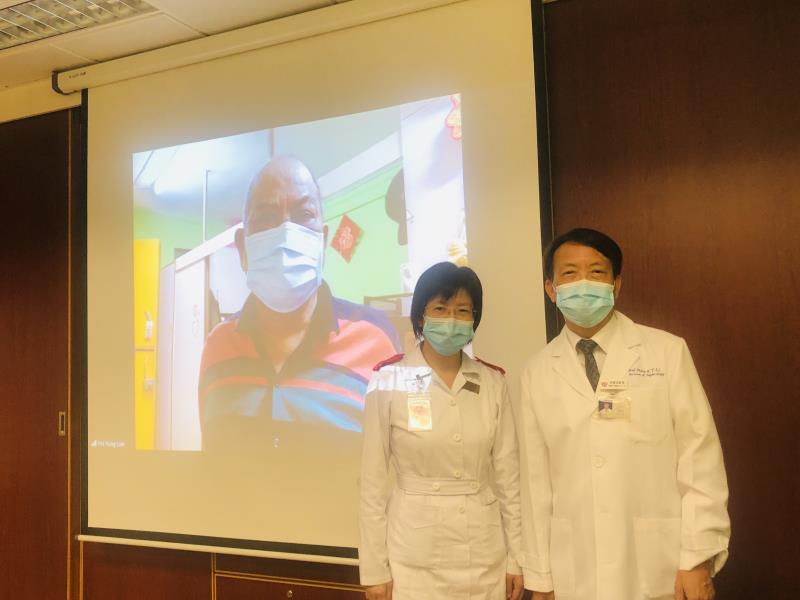Peritoneal dialysis helps mitigate COVID-19 risk in ESRD patients




 From left: A patient on home PD, Ms Man-Ching Law, Prof Philip Li
From left: A patient on home PD, Ms Man-Ching Law, Prof Philip LiSuccess of Hong Kong’s peritoneal dialysis (PD) first policy has helped patients with end-stage renal disease (ESRD) sail through the coronavirus disease 2019 (COVID-19) pandemic, with no cases of COVID-19 diagnosed in the dialysis population as of May 2020.
“Hong Kong’s PD first policy has been in place since 1985. Among the 6,097 patients on dialysis in 2018, 74.7 percent were on PD, while 25.3 percent were on haemodialysis [HD],” said Professor Philip Li, Director of the CUHK Carol & Richard Yu PD Research Centre, Chinese University of Hong Kong (CUHK). [Kidney360 2020, doi: 10.34067/KID.0000712019]
Unlike patients on HD who have to visit dialysis centres 2–3 times a week, patients on PD self-administer the treatment at home after training, and visit healthcare facilities for follow-up every 8–10 weeks. “This reduces PD patients’ exposure to the coronavirus in healthcare settings. The PD training they received also empowered them in self-care to prevent infections,” said Li.
“As a result of the success of the PD first policy, none of the patients on dialysis in Hong Kong were diagnosed with COVID-19 in the last few months,” he continued. “Other reports have shown lower rates of COVID-19 among PD vs HD patients, and among staff of PD vs HD centres.”
A study in one HD centre in Wuhan – China’s epicentre of the pandemic – showed that 16.1 percent of patients and 12.1 percent of staff were diagnosed with COVID-19 between 14 January and 17 February 2020. [medRxiv 2020, doi: 10.1101/2020.02.24.20027201]
“In another study involving multiple PD centres, COVID-19 was diagnosed in 0.52 percent of PD patients in Wuhan and in 0.11 percent of all PD patients. Among PD centre staff, 4.49 percent of those in Wuhan and 1.65 percent of all were diagnosed with COVIID-19,” said Li. “These rates are much lower than those in the HD patient and centre staff populations.”
“In addition, PD is more cost-effective, with comparable survival rates vs HD among both diabetic and nondiabetic patients. PD also has a greater protective effect than HD in preserving patients’ residual renal function,” he added.
In a recent lifetime cost-effectiveness analysis of first-line dialysis modalities under the PD first policy in Hong Kong, PD demonstrated an advantage (lifetime cost, USD 76,915; 7.13 quality-adjusted life years [QALYs]) over hospital-based HD (USD 142,389 and 6.58 QALYs, respectively). [BMC Nephrol 2020;21:42]
While continuous ambulatory PD (CAPD) is the predominant PD modality in Hong Kong, automated PD is increasingly used, accounting for 18.9 percent of the local PD population in 2018. “Dialysis efficacy is similar between the two PD modalities. The choice is often related to patients’ lifestyle rather than to ESRD severity,” Li explained. “For patients undergoing training on home PD, hospital-based automated PD is provided as a temporary treatment.”
Hong Kong’s success in implementing PD first programmes relies on patient selection, education and training for patients, caregivers and healthcare professionals, the experience and expertise of centres with dedicated PD staff and multidisciplinary dialysis clinics, and favourable government and reimbursement policies.
“The Advancing American Kidney Health [AAKH] goal of ensuring 80 percent of new ESRD patients receive home dialysis or kidney transplantation by 2025 is already achieved in Hong Kong,” said Li. “Going forward, we will promote increased use of home dialysis, including both PD and HD, for treatment of ESRD in Hong Kong.”